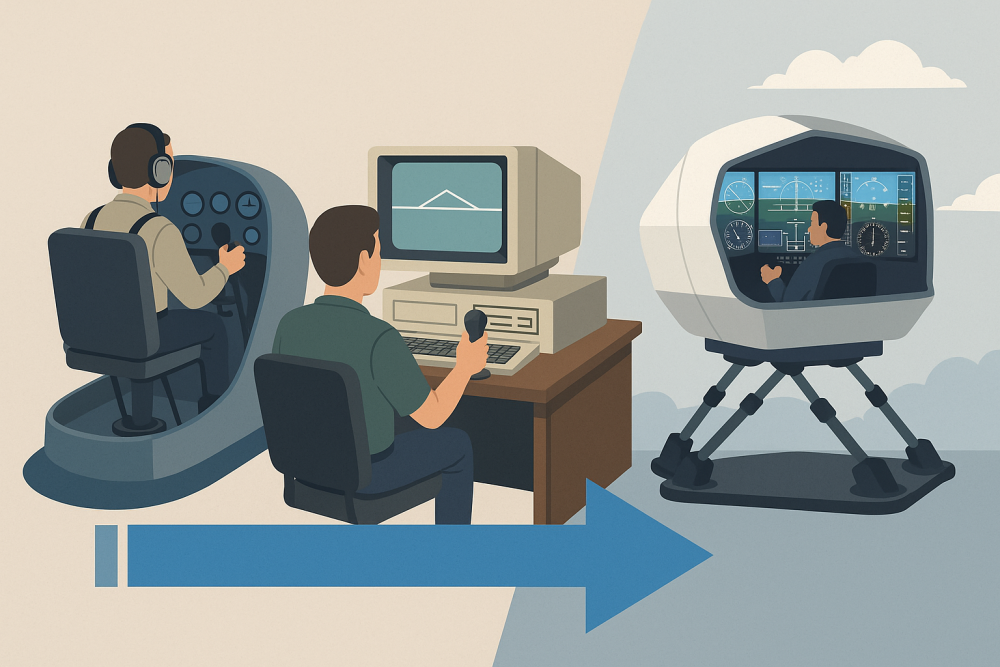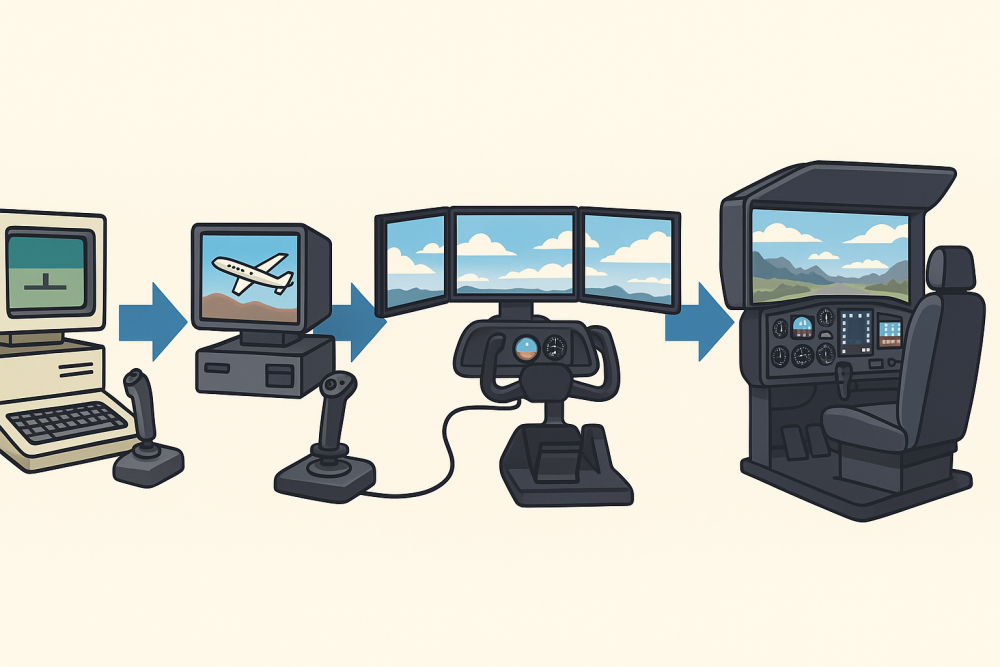
Think back to the early 1930s, a time when aviation was still a wild frontier. The skies were uncharted territories, and the need for pilots to hone their skills safely was dire. Enter the Link Trainer, also affectionately known as the “Blue Box”. This nifty piece of invention by Edwin Link was like stepping into a time machine, transporting pilots into the future of flight training.
Crafted from parts that looked more at home in a plumber’s garage than an airfield, this mechanical marvel did more than just turn heads—it gave future aviators their wings before they ever touched a real aircraft. Pilots could practice handling various flight situations without leaving the ground—it was revolutionary for the time!
The beauty of the Link Trainer lay in its simplicity fused with genius. It used a system of organ bellows and levers to mimic the controls of an aircraft. Pilots found themselves immersed in a simulated flight experience, developing the muscle memory and instincts crucial for real-world flying. Talk about forward-thinking innovation!
Safety in aviation saw a seismic shift thanks to this groundbreaking technology. Training went from a trial-and-error approach in the skies to a structured learning process that drastically reduced risks. The Link Trainer wasn’t just about teaching piloting skills; it was a critical piece in the safety puzzle, allowing for safer, more effective training initiatives worldwide.
The legacy of the Link Trainer extends far beyond its time. It laid the groundwork for future advancements in flight simulation, proving that mechanical ingenuity could offer life-saving skills training. It’s a reminder to look back and appreciate how this clever device ushered in a new era where simulation and safety in aviation would forever be intertwined.
External link for extra depth: Learn more about the Link Trainer’s development and global impact: Wikipedia – Link Trainer
From Mechanics to Circuits: The Digital Transformation of Flight Simulators

Shift gears to the 1950s and 60s—a period buzzing with technological excitement. This era witnessed the twilight of mechanical simulation and the dawn of digital. Flight simulators were no longer bound by nuts and bolts but were now driven by circuits and code. This was a game-changer for aviation training.
Digital simulation made its grand entrance, bringing real-time flight dynamics to life with a new level of authenticity. Pilots could now train in environments that felt far more realistic, while the systems modeling became detailed enough to reflect the true complexity of flying an actual aircraft. Training wasn’t just about turning knobs and levers; it became an intricate dance of digital data and physics.
Developers wove magic into these simulators, making them powerhouses of precision. Picture this: pilots manipulating controls that fed into computer systems calculating lift, drag, and more within split seconds. Training reached a new level of sophistication, preparing pilots for real-life aviation challenges with a digital twang.
Some of the early adopters of this technology had to face both skeptics and challenges. The transition from analog to digital wasn’t just flipping a switch—it meant reconceptualizing and redesigning systems. But visionaries in the field saw the immense potential this shift held and forged ahead, setting a precedent for modern simulation training.
The digital revolution in flight simulators marked a new chapter where pilots could train accurately and thoroughly. What’s the takeaway here? Always embrace innovation, even if it means leaving the comfort zone of the familiar. The move from mechanical to digital simulation highlighted the importance of evolving with advancing technology—a lesson not just for aviation, but for how we can approach any field of innovation.
A New Era in Accessibility: Sublogic’s Flight Simulator on Apple II
Roll into the 1980s, a time when personal computing was starting to catch fire. Sublogic, a name that rings nostalgic bells for many, launched its Flight Simulator, making aviation not just for big training schools but something you could explore right at home. Powered by the quirky yet beloved Apple II, this simulator brought the thrill of aviation into living rooms.
Back then, flight training was out of reach for most people—reserved for professionals or the well-funded. But Sublogic flipped the script. Suddenly, anyone with a personal computer could hop into a virtual cockpit and explore the skies, even if they were pixelated.
Sublogic’s simulator offered a gateway to experience aviation, fostering a new generation of aviation buffs and future pilots. It was all about accessibility, putting the flights into the hands of wannabe pilots who could practice flying from the comfort of their homes. You didn’t need an expensive setup or real-world maneuvers; you just needed a love for flying and a keyboard to take off.
However, it wasn’t just about gaming or casual flight. The software genuinely pushed the boundaries of what computers could do back then. Trying to render flight dynamics and landscapes on the Apple II was akin to squeezing a concert into a shoebox. Yet, Sublogic pulled it off, showing that innovation often lies just beyond the realm of possibility.
Sublogic’s legacy teaches us the power of accessibility in transforming a hobby into a widespread passion. Opening doors for enthusiasts at home sparked curiosity and knowledge sharing, laying the foundation for more sophisticated flight simulations that followed. It stands as a testament to how technology can democratize experiences previously limited to only a handful of people. Explore related setups in Getting Started with Flight Simulation: A Step-by-Step Guide
Redefining Realism: Milestones in Microsoft Flight Simulator Development

Step into 1982, when Microsoft decided to take flight. Microsoft Flight Simulator 1.0 was like a rocket launch for the home simulation market. Its release marked a turning point for aviation enthusiasts everywhere, suddenly able to interact with more detailed and responsive virtual fly zones, all from their computer desks.
Fast forward to 1993, when FS5 entered the scene and upped the ante even further with textures that painted the digital skies. This version marked the beginning of flight sims striving for visual realism. Sat imagery got fans talking about landscapes finally resembling the real thing, stretching imaginations about what these programs could do.
By the time FS98 rolled around, it was like strapping a jet engine to a bicycle, thanks to DirectX and its savvy use of 3D hardware. The visuals popped like never before, bringing a new level of immersion. You could almost feel the clouds pass by as graphics took a massive leap towards realism, redefining expectations for every simulator released after.
FS2000 introduced weather effects and let players swoop into thousands of accurately depicted airports worldwide. It wasn’t just about better graphics—the introduction of weather systems and accurate terrain made flying feel far more lifelike. Simulators had clearly outgrown their “game” status and were now immersive adventures in their own right.
The key takeaway from Microsoft’s journey? Sticking to a development philosophy rooted in realism and expansion created new standards in the simulation world. They didn’t just create a tool for pilots but built a global phenomenon for everyone from hobbyists to veteran flyers. Their continued innovation inspired countless others to dream bigger, proving that even the sky isn’t the limit. Compare modern sim platforms in our post FSX vs FS2020: How Visuals Evolved.
Enter the Age of Hyper-Realism: Microsoft Flight Simulator 2020 and Beyond

Leap into the modern day with Microsoft Flight Simulator 2020—an experience that turned heads and wowed even the most seasoned flyers. This wasn’t just another update; it was a complete reinvention of what simulation could be. Powered by Azure AI and backed by a massive library of satellite data, this version offered a staggeringly detailed digital Earth right at your fingertips.
This iteration didn’t just show you a flat map of the planet. It was like flying over real-world cities and landscapes rendered with uncanny accuracy. If you were keen to find the street you live on or check out iconic landmarks from a bird’s-eye view, this was your ticket to the world. The ability to virtually navigate the entire globe shifted user expectations dramatically.
With FS2024 on the horizon, prepare for another leap forward in realism. Photogrammetric cityscapes and a new career mode promise to challenge pilots in fresh, engaging ways. It’s not just eye candy—this is about crafting immersive experiences where every flight feels like a mission with purpose.
Future simulators will likely build on this reality-draping approach, pushing even closer to blending virtual with reality seamlessly. These technological strides aren’t only reshaping the flight sim community; they’re influencing training programs, urban planning, and beyond—proving that the spectrum of flight simulators extends far beyond the cockpit. How photorealism and Azure cloud tech powered this evolution: Aerosociety overview
The overarching lesson from this high-tech transformation? Keep investing in cutting-edge tech to enhance experiences. The realism achieved by these tools is continuously evolving, giving more depth to learning, exploring, and experimenting—all from the comfort of a home cockpit. As we soar into the future, it’s clear this new era of hyper-realism promises endless possibilities for pilots and gamesters alike.
Final Thoughts
This journey—from the mechanical ingenuity of the Link Trainer to the cloud-powered hyper‑realism of today—is more than history—it’s a testament to human curiosity and innovation. These tools have bridged the gap between imagination and reality, turning simulators into training essentials and creative playgrounds.
Interested in where we go next? Whether it’s VR integration, AI-driven airports, or full-motion rigs, we’re flying into the future together.
Fly On—Explore Further:
- Explore gear & setup tips: Essential Hardware Upgrades
- Dive into immersive VR: Guide to Flight Sim VR
- Learn safe flying techniques: Pilot Training Fundamentals
